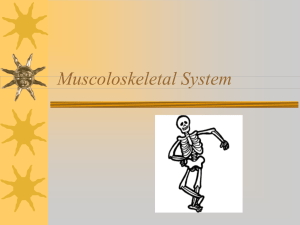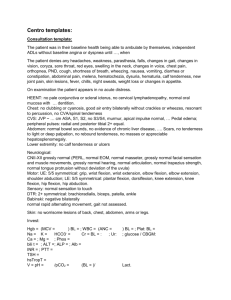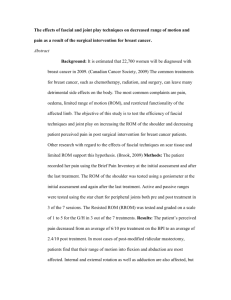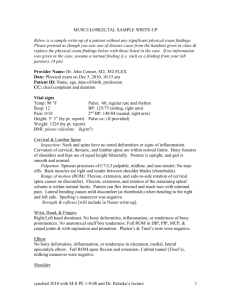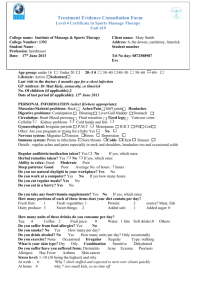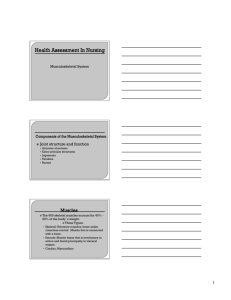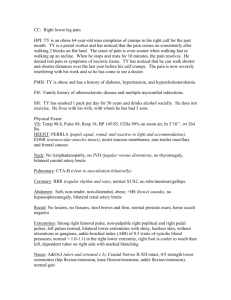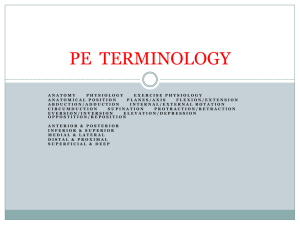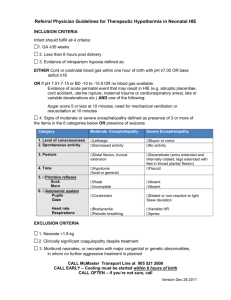Examination of the Joints
advertisement
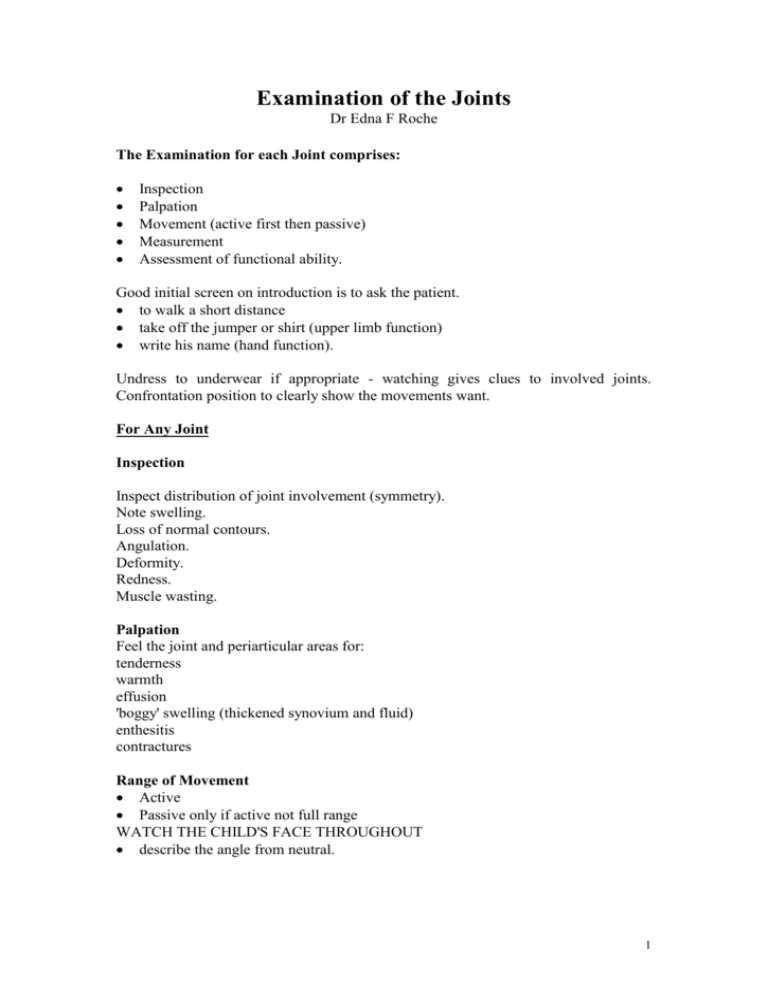
Examination of the Joints Dr Edna F Roche The Examination for each Joint comprises: Inspection Palpation Movement (active first then passive) Measurement Assessment of functional ability. Good initial screen on introduction is to ask the patient. to walk a short distance take off the jumper or shirt (upper limb function) write his name (hand function). Undress to underwear if appropriate - watching gives clues to involved joints. Confrontation position to clearly show the movements want. For Any Joint Inspection Inspect distribution of joint involvement (symmetry). Note swelling. Loss of normal contours. Angulation. Deformity. Redness. Muscle wasting. Palpation Feel the joint and periarticular areas for: tenderness warmth effusion 'boggy' swelling (thickened synovium and fluid) enthesitis contractures Range of Movement Active Passive only if active not full range WATCH THE CHILD'S FACE THROUGHOUT describe the angle from neutral. 1 Test Function - correlates with strength For all joints: hands, wrists, elbows, shoulders, tm joints, cx spine, lumbar spine, hips, knees, ankles, feet. Start with child sitting on a chair/bed with the hands resting on the thighs. Upper Limbs Hand and Wrists: Look at dorsum of the hand first; note any skin rash or muscle wasting. Methodically inspect the wrist, MCP, PIP, DIP joints and Nails. Get the child to turn the hand over and look at palmar same way. Palpate each joint for tenderness and effusion. Flex and extend the child's fingers while palpating over the flexor tendon sheathes (for synovitis). Check ROM (active then passive). 1. 2. 3. 4. Wrist: flexion (800), extension (700), R. devn (200), U. devn (300) MCP jts: flexion (900), extension (300). PIP jts: flexion (1000). DIP jts: flexion (900), extension (100). Thumb: Can flex to contact the tips of the other fingers, and abduct from the index finger (500). Now test function: grip strength, write with a pencil; use knife, fork, cup, spoon; hold toothbrush; undo and do up buttons; turn key. Elbows: Inspect, palpate, check ROM. 1. Flexion (1350) 2. Extension (0-100) 3. Supination (900) 4. Pronation (900) Supination and pronation should be tested with the elbow flexed (if possible) at 900 a pencil in the hand may help. Functionally: check if child can turn an imaginary doorknob, comb hair, hang out the washing, answer the telephone. 2 Shoulders: Inspect and palpate. Check ROM with play in younger child. 1. 'Put your hands above your head' and demonstrate. Tests flexion (900) and abduction (1800). 2. 'Give yourself a hug' and demonstrate. Tests adduction (450). 3. 'Scratch your back' and demonstrate. Tests external rotation (450). 4. 'Hide your hands behind your back' and demonstrate. Tests internal rotation (550) and extension (450). Test Function; some overlap with elbow; comb hair, take off clothes, hang out washing, scratch near bottom (toileting function), use a telephone. Jaw and Neck Look at the jaw (especially for acquired micrognathia) Feel for crepitus over the TMJ's with opening/closing mouth. Examine Cervical spine: Inspect, Palpate, ROM. 1. 2. 3. 4. Flexion (chin touches chest; 450) Extension (head touches back; 500) Rotation (chin in line with shoulder; 800) Lateral flexion (ear to shoulder; 400) THORACOLUMBAR SPINE: Inspect with child standing and then bending forward (for scoliosis or kyphosis). Palpate for tenderness. Check ROM. 1. 2. 3. 4. Flexion (should be able to touch toes). Extension (arching back; 300 at lumbar area). Lateral bending (500 to each side). Lateral rotation (best checked with child sitting; 300 each side). Test function: Pick up an object from floor. Put on socks and shoes. SACROILIAC JOINT Palpate for tenderness over the joint. Pelvic work test - press the pelvis from both sides towards the midline to assess for pain. 3 Lower Limbs Watch the child walk. Stand on each leg (Trendelenberg sign). Squat (for proximal weakness or instability). Hips: Inspect the resting position and muscle bulk. Palpate for tenderness. Measure the true leg length (ASIS to medial malleolus). Lying on the back - check ROM. Flexion (1200) can be checked first with active movement. Then Thomas test for fixed flexion deformity Then test: 1. Internal rotation (350) 2. External rotation (450) Both tested with hips at 900 flexion. 3. Abduction (500). 4. Adduction (300). Note the pelvis should be stabilised (by handfixing the ASIS) when checking all these movements. Turn over onto abdomen and test extension (300). Test Function: gait is sufficient. Knees: Inspect - noting quadriceps bulk. Feel - for temperature, tenderness and palpate entheses (10, 2, 6 o'clock position on the patella) and for any synovial thickening or effusion. Test for the 'bulge sign' by milking any joint fluid down the lateral aspect of the joint (look for the bulge medially) and then stroke upwards on the medial aspect moving any fluid present into the suprapatellar bursa. Test for a patellar tap (careful can hurt). Measure - muscle bulk of thighs and calves if appear different (at fixed pt above patella e.g. 5-10cm and 10cm below the tibial tuberosity). If not already done, measure leg length. Check ROM - flexion (1350) - extension (up to 100) 4 Check Knee Stability: (not if knee acutely inflamed) Test for AP movement with the knee joint flexed with position fixed by sitting on the child's foot. Check for the 'drawer' sign signifying damage to the cruciate ligaments (anterior cruciate ruptured is ruptured if there is movement when the leg is pulled forward; posterior if movement when leg is pushed back). Check for lateral mobility with the knee fully extended, for lesions of the medial/lateral ligament; normally there is no lateral movement. Ankles and Feet: Inspect for: swelling loss of definition of the Achilles tendon (synovial thickening at the ankle joint) Palpate the ankle joint enthuses (Achilles into calcaneus, metatarsal heads, plantar fascia insertion to calcaneus). Check ROM 1. Ankle: plantar flexion (500); extension (dorsiflexion 200). 2. Subtalar joint: inversion (50), eversion (50). 3. Midtarsal (talonavicular and calcaneocuboid) jts: abduction (100); adduction (200). The midtarsal joint is tested by stabilising the calcaneus with one hand and moving the forefoot with the other. 4. First Metatarsophalangeal joint: plantar flexion (450); extension (dorsiflexion 700). Note any crepitus or pain on moving the 1st MTP joint (may be selectively involved in spondyloarthropathies). 5


